When we open a book, we often find two key elements: the index and the table of contents. Though they may seem similar, there are some differences between the index and table of contents. While they share the common goal of enhancing document accessibility, the Index and Table of Contents differ significantly in their structures and functions.
For those who work with digital documents, there's an effective tool: Wondershare PDFelement. This software simplifies creating and navigating both indexes and tables of contents in PDFs. It's a handy alternative for managing large documents, offering ease and efficiency.
In this article
Part 1. Table of Contents VS. Index: Which One To Add to Your Document?
Choosing between a table of contents and an index for your document? It's important to know what each one does. A table of contents is like a map. It shows the major parts of your document, like chapters or sections, right at the beginning. It's great for giving readers a quick overview.
On the other hand, an index is more detailed. It's a list at the end of your document. It points to specific pages where you can find topics, names, or key terms. So, what should you add?
Part 1.1. Table of Contents VS. Index - Table of Contents Overview
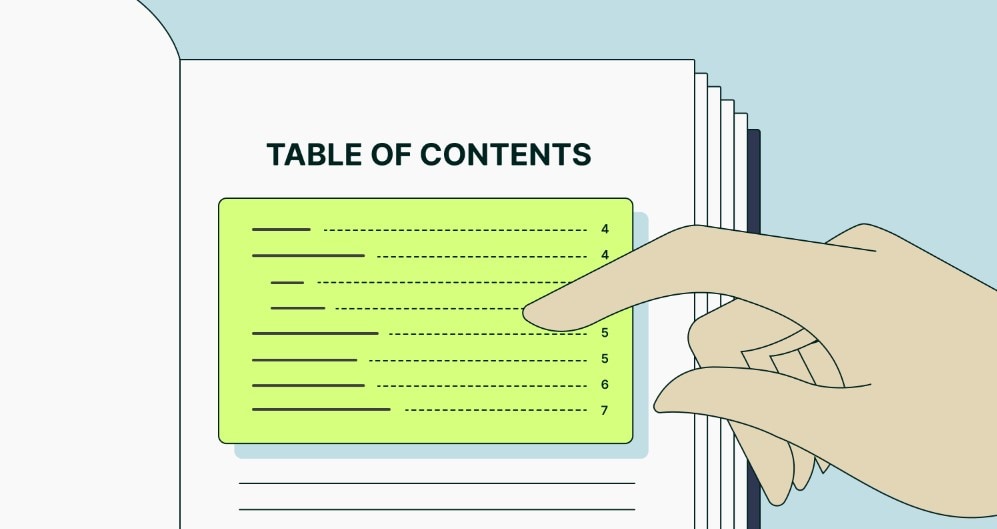
A table of contents is like the first guide you meet in a book or a big document. It sits at the start, showing you the main parts: the chapters, sections, or topics. Each part has a title and a page number next to it. This makes it easy for you to jump right to the section you want.
Why add a table of contents? It's simple. It helps your readers. They can quickly review it and get a feel for its cover. It's like a preview, showing them what to expect. This is super helpful, especially in long documents.
The benefits of a table of contents are clear. It saves time. Readers don't have to flip through pages to find what they need. It organizes your document, making it look professional. It also helps readers remember where they saw something interesting. They can just go back to the table of contents and find it easily.
A table of contents is a handy tool. It makes your document friendly and easy to navigate. If you want your readers to find information quickly and understand how your document is set up, adding a table of contents is smart.
Part 1.2. Index VS. Table of Contents - Index
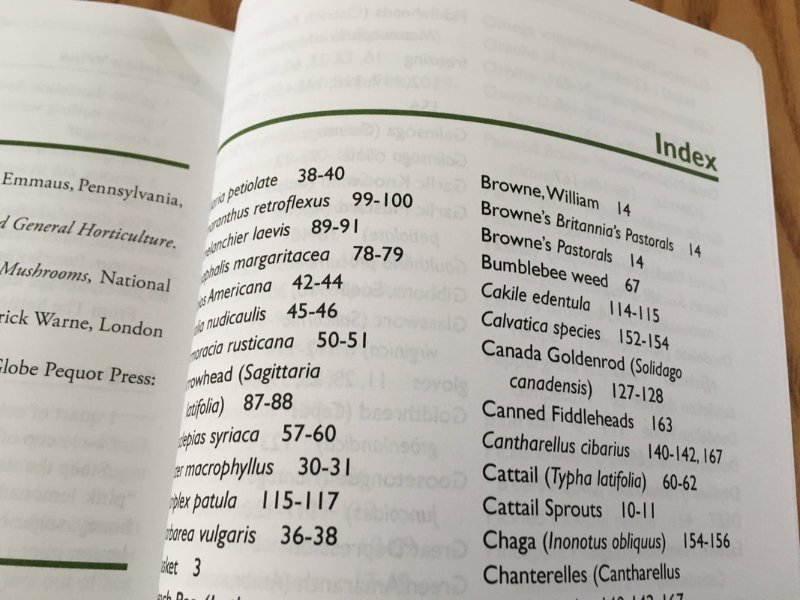
An index is a detailed guide at the end of a book or long document. Unlike the table of contents, an index doesn't just list chapters or sections. It contains keywords, names, topics, and sometimes even important phrases. Next to each item, you'll find page numbers. These tell you where to find more information about that topic in the document.
Why is an index important? Imagine you remember a specific thing from a book but not where it is. The index is your tool for finding this information. You just look up a keyword that points you to the right pages. This is especially useful in detailed or technical documents. It's like a search tool but for a printed document.
Adding an index has several benefits. It makes your document more user-friendly. Readers can easily find detailed information without reading everything. It's great for reference materials, where people often look up specific topics or terms. An index adds value to your document, making it more useful and accessible.
An index is a powerful feature for any detailed document. It helps readers find specific information quickly and easily. If your document covers many in-depth topics, including an index is a wise choice.
Part 1.3. Difference Between Table of Contents and Index
Understanding their differences is key when deciding between a table of contents and an index. Here's a simple table to highlight these differences:
| Feature | Table of Contents | Index |
| Location | ● At the beginning of the document. | ● At the end of the document. |
| Lists | ● Chapters, sections, or main topics. | ● Keywords, names, specific info. |
| Purpose | ● Provides an overview of the document. | ● Helps find specific information. |
| Order | ● Follows the document's structure. | ● Alphabetical order. |
| Use Case | ● Ideal for navigating through sections. | ● Best for searching details. |
Now, let's dive a bit deeper with some explanations.
The table of contents is your first stop in a document. It shows the main parts in the order they appear. It's like the summary of a story, telling you what chapters or sections are inside. When you want a quick overview or need to go to a certain chapter, the table of contents is your friend.
On the other side, the index is more like a detective. It lives at the end of the document. It's full of keywords, names, and topics. Each one points to specific pages where you can find more about them. It's useful when you remember a detail but don't know where it is in the document. The index helps you find it without the need to read everything again.
Both a table of contents and an index have their roles. The table of contents guides you through the structure of the document. The index, however, is more about finding specific things fast. Knowing when to use each can make your document much easier.
Part 2. How To Create a Table of Contents in a PDF
Creating a table of contents in a PDF might sound tough, but it's pretty easy with the right tool. One great option is Wondershare PDFelement. This tool is designed to make working with PDFs simple and fast.

Why choose PDFelement? Well, it's user-friendly. That means you don't need a tech expert to use it. You can add a table of contents to your PDF with just a few clicks. This is super helpful, especially if you're dealing with long documents. A table of contents makes it easier for anyone reading your PDF to find what they need quickly.
Think of PDFelement as a helper that takes the stress out of organizing your PDFs. Whether it's a report, a book, or any other long document, having a table of contents can make a big difference. It turns your PDF into a well-organized, professional-looking document.
So, if you've got a PDF that needs a table of contents, PDFelement is a tool worth trying. It's about making your document reader-friendly without needing to learn complicated steps.
Creating a clickable table of contents in a PDF is straightforward with Wondershare PDFelement. This tool lets you make a table of contents that readers can use to jump to different sections easily. Here's a simple way to do it:
- Open your PDF in PDFelement.

- Look through your document and decide where you want the links in your table of contents to go.
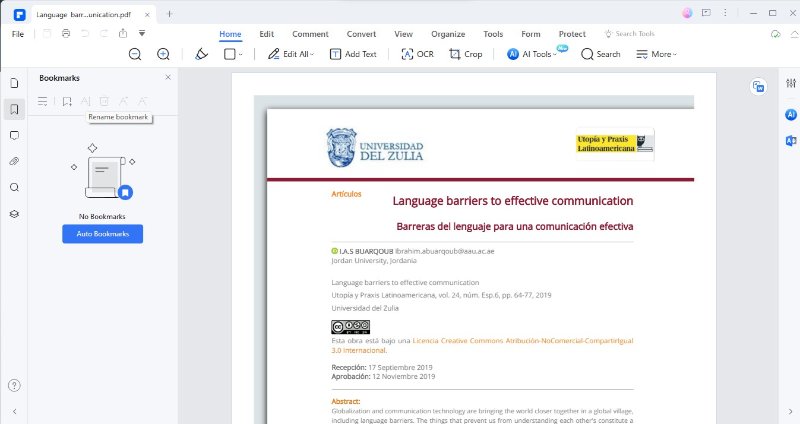
- Select the text you want as a heading in your table of contents.
- Click on the "Bookmark" option in the toolbar.
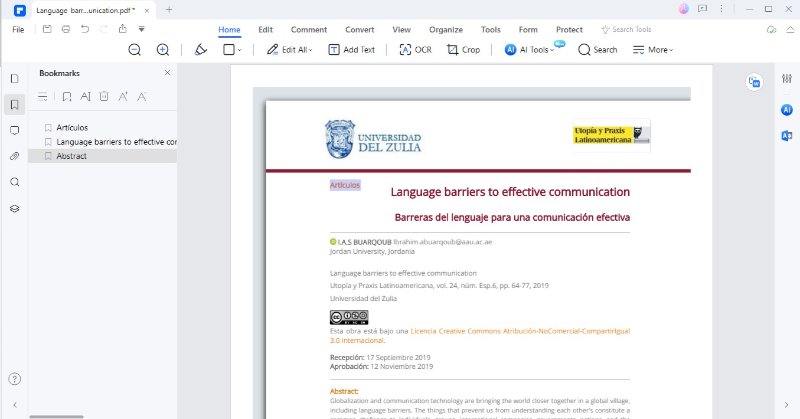
- Find the bookmark on the bookmark panel on the left side of your screen and right-click on it.
- A menu will pop up. Click this menu's "Create a Contents Page from Bookmarks" option.
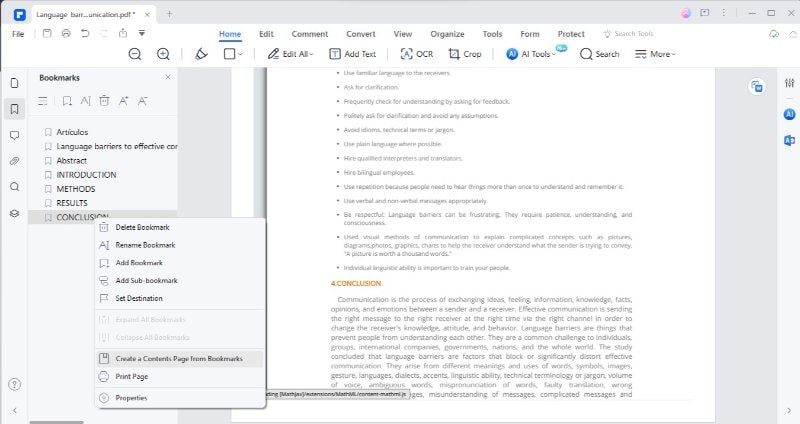
After you select this, PDFelement gets to work. It takes all your bookmarks and turns them into a table of contents. This table is automatically added to your PDF.
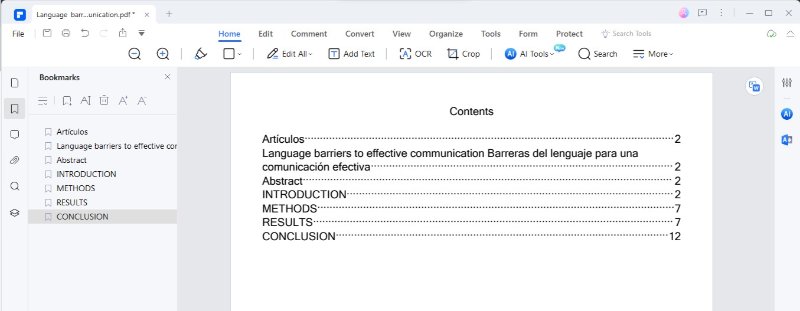
The cool part about this table of contents is that it's not just a list. It's full of links. Each item in the table of contents is a clickable link. When you click on any of these items, PDFelement instantly takes you to that section in the PDF.
With PDFelement, your document has a handy, professional-looking table of contents. It's easy for anyone to use and helps them find what they need fast. This tool ensures your PDF is neat and reader-friendly, regardless of who opens it or where.
Conclusion
There are some differences between a table of contents and an index. Both are important in a document, but they serve different purposes. A table of contents gives a quick overview of the sections or chapters at the beginning, while an index at the end lists keywords and topics with page numbers for detailed searching. Understanding these differences helps you decide which one to include in your document.
Adding a table of contents is simple for those working with PDFs with Wondershare PDFelement. This user-friendly and efficient tool turns a complex task into an easy one. It allows you to create a clickable table of contents quickly, enhancing the usability of your PDFs.

 G2 Rating: 4.5/5 |
G2 Rating: 4.5/5 |  100% Secure
100% Secure



